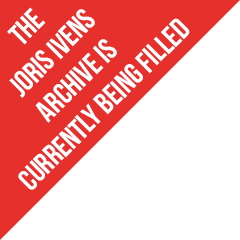

100 years ago, Joris Ivens filmed The wigwam.
Hundred years ago, in the spring of 1912, Joris Ivens filmed his first fictionmovie called The wigwam at an thirteen years old age. The filmshootings took place in the woods near the Heidevensweg and the uncultivated hills of the Kwakkenberg in Nijmegen. Ivens’ film career started with this film, which continued for 75 years and resulted in 80 films in the end. On Friday 29th of June, the festival Il Cinema Ritrovato in Bologna will focus on The wigwam and the film will be presented in their program ‘Centi anni fa’.
Meaning
In Dutch film history, The wigwam is considered as one of the first home-movies: Amateurfilms recorded with simple equipment within a family situation. The family members are enthusiastically playing a white farmer family of which the youngest daughter is being kidnapped by an evil indian. The good Indian, played by Joris Ivens himself, is bringing the daughter home safely, after a wild chase. That’s why the alternative title is called The history of the abduction of a child in Canada near Nijmegen. The camera that they used for the shooting of the film, was very special and luxury in that time. Ivens took it out of the photography shop of his father. Although Ivens declared that he wasn’t the ‘Mozart of film’ because of this early film, nevertheless the innocent film did get a lot of meaning because there are so many characteristics of his later films in it. Typical similarities between The wigwam and his later film are for example the struggle between good and bad, the staged scenes and the Happy Ending like always. Especially his last film, A tale of the wind (1988), has obvious similarities with his firstling, like the main role in the film for example, that is being played by Joris Ivens himself.
Production
The young Ivens had seen some Cowboy and Indianmovies (‘Westerns’) during the fair in Nijmegen in 1911. The abduction by the‘redskins’ was extremely interesting according to Ivens. On top of that, he read the still extremely popular adventure books of Karl May and after that, the fantasy of Ivens went completely mad. Joris – who was still called ‘George’ at that moment- moved the conflict from the woods in Canada to Nijmegen. There is a big chance that the first test recordings are recorded in the big yard of the house of the Ivens-family, on the Berchenstraat in Nijmegen. On the photo’s of 1910 and 1911 we see the young Ivens behind a filmcamera and a tripod.
On other photo’s we see him play an Indian with tent and horse. Witnesses within the family remembered very well that the horse walked right through the house to the backyard, and that while doing this,the horse pushed a gas pipe from it’s place and this resulted in a dangerous situation. The pictures from the backyard aren’t used in the final film because they decided to film further outside to increase the reality and credibility of the film. ‘For shooting location, the woods around Nijmegen seemed very appropriate, especially because of all the green colours during spring.’ Reported the record of the first screening with audience. The estate ‘Heydepark’, that is visible in the film many times, still exists (it’s called ‘de Goffert’ now) but ‘de Kwakkenberg’ where the chase takes place, is unrecognizable now because it has changed so much since then. These two pieces of land were property of the notable catholic merchant families: The Dobbelmann family (of the international soap and detergent factory) and the Jurgens family, the founders of the multinational Unilever.
Filmart
‘The screening of local, selfmade Kino-shots, attracts bigger attention than any other film, no matter how stunning it is.’ Wrote father Kees Ivens down. The film indeed received a lot of appreciation from family and the professional circle: ‘very amusing, interesting and instructive’ wrote the photomagazine LUX down in 1916. Kees Ivens had visited in 1896 the first filmscreening in the Netherlands with the Cinématographe of Lumière and predicted in the local and national media that this invention of the film will become just as important as the invention of the printing. At an early stage, he added a film section in his photography-shop. When his son started working with his film equipment, he wrote proudly ‘Kinoman’ underneath a picture of Joris Ivens with a filmcamera: Another prediction that came to pass.
The European Foundation Joris Ivens has done extensive research on the origin of the different versions of the film, about which there are no direct sources available . The wigwam has been presented Friday 29th of June by the European Foundation Joris Ivens on the festival for old films in Bologna.
Besides that, Ivens will be ‘present’ at an exposition Heroes from Nijmegen on supporting bases. On the 12th and 13th of October The Wigwam will be screened together with a lecture during the event ’24 hours history from Nijmegen’ . Untill the 30th of September the film ‘Borinage’ will be permanently shown during the ‘Manifesta 9’, the European Biënnale for temporary art in Genk.
The Dutch state museum is working on a exhibition about modernism in the 20th century with a whole airplane, works of Gerrit Rietveld, Piet Mondriaan and Joris Ivens. The expectation is that exhibition will be opened next year.